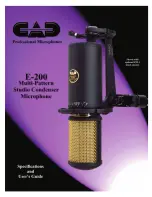
Microphones and preamplifiers work together like a team and
some are just better matches than others.
The R-122 active ribbon microphone is capable of substantial
output signal, especially if used in conjunction with very loud
signal sources such as guitar amplifiers. It is therefore recom-
mended that the microphone preamplifier have a switchable
pad to prevent the possibility of overloading the preamplifier’s
input stage electronics. Some preamplifiers are more thought-
fully designed than others, and a suitable pad will be provided
before the active electronics, not incorporated into a “feedback
loop” as some cheaper models do. The latter design could still
produce unwanted distortion due to overloading, even if the pad
were used. Although this is rarely an issue, we felt that it was
important to cover the subject.
In conclusion, preamplifier coloration is optional and a matter
of personal taste. Some people love the effect of coloration
while others strive for absolute transparency.
Equalization & Ribbon Microphones
One of the great strengths of ribbon microphones is how well
they take EQ. Even with substantial amounts of equalization,
ribbons retain their natural, “real” quality. For example, when a
lead vocal is being performed on an R-122, you can actually
boost upper-end frequencies to the point where the R-122 emu-
lates the performance curve of a condenser mic with excellent
results. This is not to say that ribbon microphones can replace
quality condenser mics in all circumstances, but the EQ friend-
liness inherent in ribbon microphones does allow for an enor-
mous amount of flexibility.
The reason that ribbon mics take EQ so well is their inherent
low self-noise (less than 15dB), unusually smooth response
characteristics, and freedom from off-axis coloration. Dialing
in high amounts of equalization on condenser or dynamic
10
Содержание 122v
Страница 28: ...Polar Pattern Frequency Response 27 ...
Страница 29: ...Notes 28 ...
Страница 30: ...29 ...
Страница 31: ...30 ...
Страница 32: ...31 ...












































